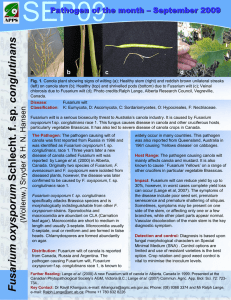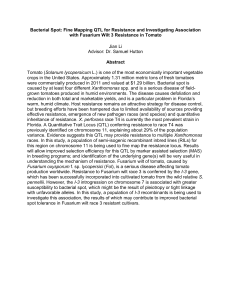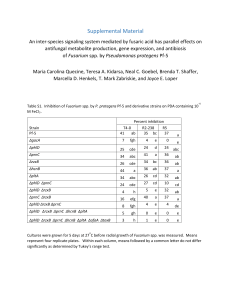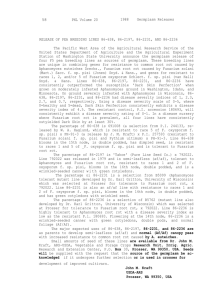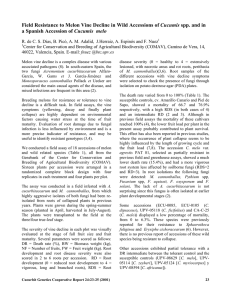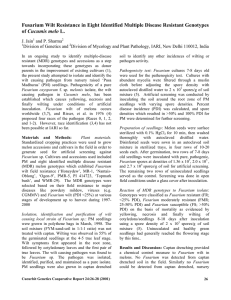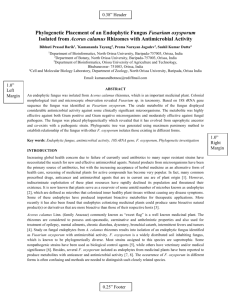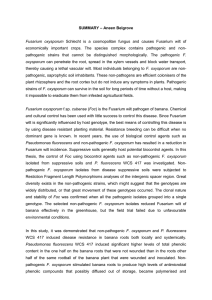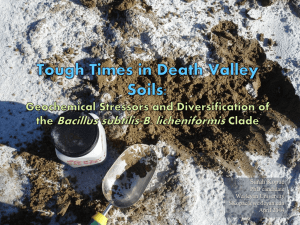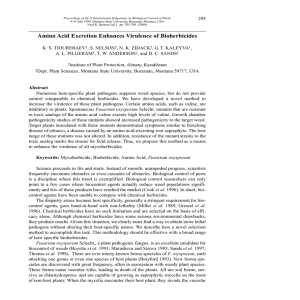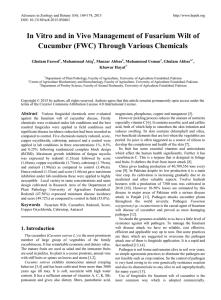Cucumis melo melo
advertisement
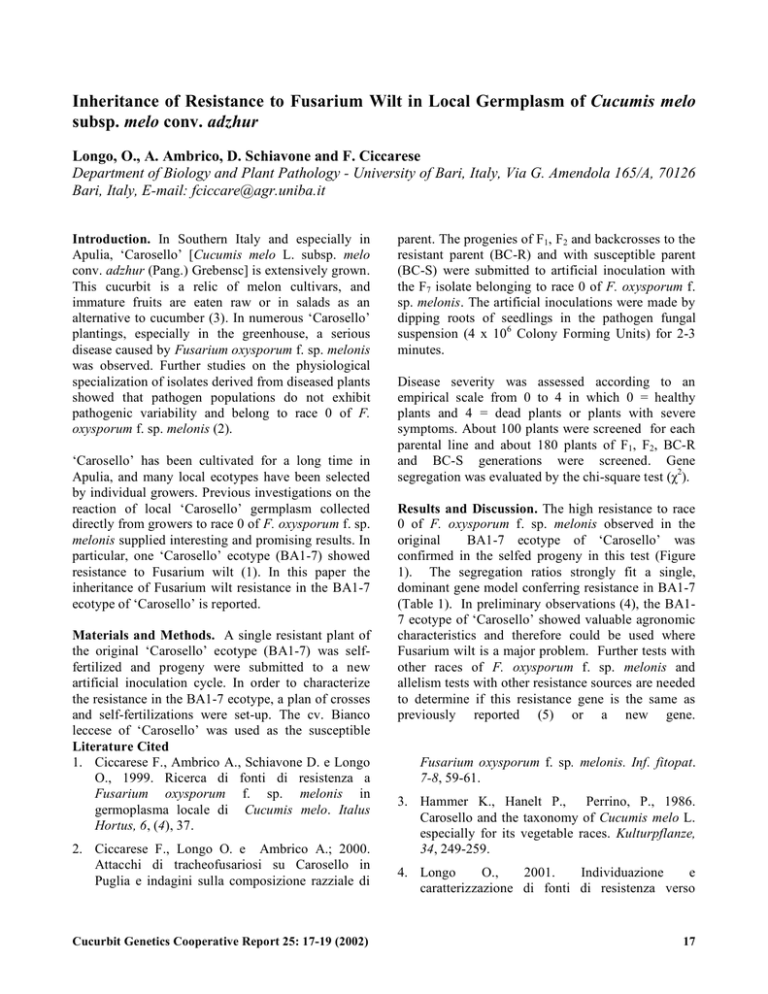
Inheritance of Resistance to Fusarium Wilt in Local Germplasm of Cucumis melo subsp. melo conv. adzhur Longo, O., A. Ambrico, D. Schiavone and F. Ciccarese Department of Biology and Plant Pathology - University of Bari, Italy, Via G. Amendola 165/A, 70126 Bari, Italy, E-mail: fciccare@agr.uniba.it Introduction. In Southern Italy and especially in Apulia, ‘Carosello’ [Cucumis melo L. subsp. melo conv. adzhur (Pang.) Grebensc] is extensively grown. This cucurbit is a relic of melon cultivars, and immature fruits are eaten raw or in salads as an alternative to cucumber (3). In numerous ‘Carosello’ plantings, especially in the greenhouse, a serious disease caused by Fusarium oxysporum f. sp. melonis was observed. Further studies on the physiological specialization of isolates derived from diseased plants showed that pathogen populations do not exhibit pathogenic variability and belong to race 0 of F. oxysporum f. sp. melonis (2). ‘Carosello’ has been cultivated for a long time in Apulia, and many local ecotypes have been selected by individual growers. Previous investigations on the reaction of local ‘Carosello’ germplasm collected directly from growers to race 0 of F. oxysporum f. sp. melonis supplied interesting and promising results. In particular, one ‘Carosello’ ecotype (BA1-7) showed resistance to Fusarium wilt (1). In this paper the inheritance of Fusarium wilt resistance in the BA1-7 ecotype of ‘Carosello’ is reported. Materials and Methods. A single resistant plant of the original ‘Carosello’ ecotype (BA1-7) was selffertilized and progeny were submitted to a new artificial inoculation cycle. In order to characterize the resistance in the BA1-7 ecotype, a plan of crosses and self-fertilizations were set-up. The cv. Bianco leccese of ‘Carosello’ was used as the susceptible Literature Cited 1. Ciccarese F., Ambrico A., Schiavone D. e Longo O., 1999. Ricerca di fonti di resistenza a Fusarium oxysporum f. sp. melonis in germoplasma locale di Cucumis melo. Italus Hortus, 6, (4), 37. 2. Ciccarese F., Longo O. e Ambrico A.; 2000. Attacchi di tracheofusariosi su Carosello in Puglia e indagini sulla composizione razziale di Cucurbit Genetics Cooperative Report 25: 17-19 (2002) parent. The progenies of F1, F2 and backcrosses to the resistant parent (BC-R) and with susceptible parent (BC-S) were submitted to artificial inoculation with the F7 isolate belonging to race 0 of F. oxysporum f. sp. melonis. The artificial inoculations were made by dipping roots of seedlings in the pathogen fungal suspension (4 x 106 Colony Forming Units) for 2-3 minutes. Disease severity was assessed according to an empirical scale from 0 to 4 in which 0 = healthy plants and 4 = dead plants or plants with severe symptoms. About 100 plants were screened for each parental line and about 180 plants of F1, F2, BC-R and BC-S generations were screened. Gene segregation was evaluated by the chi-square test (χ2). Results and Discussion. The high resistance to race 0 of F. oxysporum f. sp. melonis observed in the original BA1-7 ecotype of ‘Carosello’ was confirmed in the selfed progeny in this test (Figure 1). The segregation ratios strongly fit a single, dominant gene model conferring resistance in BA1-7 (Table 1). In preliminary observations (4), the BA17 ecotype of ‘Carosello’ showed valuable agronomic characteristics and therefore could be used where Fusarium wilt is a major problem. Further tests with other races of F. oxysporum f. sp. melonis and allelism tests with other resistance sources are needed to determine if this resistance gene is the same as previously reported (5) or a new gene. Fusarium oxysporum f. sp. melonis. Inf. fitopat. 7-8, 59-61. 3. Hammer K., Hanelt P., Perrino, P., 1986. Carosello and the taxonomy of Cucumis melo L. especially for its vegetable races. Kulturpflanze, 34, 249-259. 4. Longo O., 2001. Individuazione e caratterizzazione di fonti di resistenza verso 17 Fusarium oxysporum f. sp. melonis in germoplasma locale di Cucumis melo. Thesis of PhD in “Plant Pathology”, Department of Biology and Plant Pathology - University of Bari, Italy, pp. 73. 5. Risser G., Banihashemi Z., Davis D. W., 1976. A proposed nomenclature of Fusarium oxysporum f. sp. melonis races and resistance genes in Cucumis melo. Phytopathology, 66, 1105-1106. Cucurbit Genetics Cooperative Report 25: 17-19 (2002) 18 Table 1 - Observed segregation for Fusarium wilt resistance of the BA1-7 ecotype of ‘Carosello’ (Cucumis melo L. subsp. melo conv. adzhur) and Chi-square ( χ2 ) goodness of fit test. Number of plants R:Sa Ra S Expectedb ratio BA1-7 98 0 98:0 - - Bianco leccese 0 96 0:96 - - F1 185 0 185:0 - - F2 125 44 127:42 0.031 > 0.90 BC-R 169 0 169:0 - - BC-S 98 96 97:97 0.021 > 0.90 Pedigree a χ2 P R =resistant and S = susceptible single, dominant gene model for inheritance of resistance b Bianco leccese Original BA1-7 ecotype Self-fertilization BA 1-7 ecotype 100 90 80 Plants (%) 70 60 50 40 30 20 10 0 0 1 2 3 4 Disease Rating Figure 1 - Reactions to Fusarium oxysporum f. sp. melonis race 0 of cv Bianco leccese, and the original and selfed BA1-7 ecotype of ‘Carosello’. Disease rating scale: 0 = healthy, no symptoms to 4 = plant death, very severe symptoms. Cucurbit Genetics Cooperative Report 25: 17-19 (2002) 19
